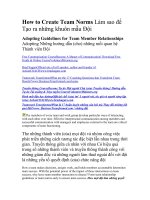how to create a paper airplane
Bạn đang xem bản rút gọn của tài liệu. Xem và tải ngay bản đầy đủ của tài liệu tại đây (34.03 KB, 2 trang )
Instructions for Making a Paper Airplane
Materials:
1.One sheet of smooth, stiff paper. Use a standard sheet (8½ x 11 inches). Make sure it has 90°
corners and straight edges.
2.A flat and smooth work surface.
It should be sturdy, and at least as big as the paper.
Procedure:
1.Fold the paper in half lengthwise. Crease the fold, then turn it inside out and crease again.
(Open up the folded page and fold it along the same line in the opposite direction.) Make sure
that the edges are aligned so that they meet when the paper is folded in half.
2.Fold down the top left corner so that the top edge meets the middle fold. Then, fold down the
top right corner the same way. Make sure that the new folds squarely meet the middle crease.
3.Fold the point down. Step two formed a
"point" at the top of the page. Fold this
point down (toward you) so that the flaps
formed in step two are on the inside of the
fold. Make the fold as high up on the page as
possible without folding or crushing the flaps
which are on the inside of this fold.
4.Fold in half lengthwise (along the first crease
from step 1) towards the back so that the
folded-down point is on the outside of the
fold.
5.Tear or cut a notch in the upper corners. If you have scissors available they will provide an
easier and more attractive way to make the notches. Remove a square (about ½ inch) from the
outer corners. Make sure you do not cut your notch along the center fold.
6.Open the fold from step four so that the point is again on top and pointed toward the bottom of
the page. The notched corners will be at the top of the page.
7.Fold down the top left corner so that the top edge of the left half of the page is aligned with the
center fold. Then, fold down the top right corner in the same way. This step is very similar to step
two.
8.Fold up the tip of the point to hold the flaps in place. Step seven created two "flaps" which
expose the tip of the point through the notches created in step six. Fold the exposed tip of the
point up so that it covers the edges of the two flaps. This will hold those flaps in the proper
position during flight.
8.Fold the right side of the page back along
the center fold so the flaps and point are exposed on the outside. This creates two panels folded
back-to-back along the center fold, with the notches and upturned point on the outside of the fold
and the inside faces of the panels being smooth.
9.Rotate the page clockwise 90° so that the angled portion is to the right and the square end is to
the left. Fold down the right wing. This fold lifts just the top panel created in step 8 and folds it
"in half" so that the angled upper edge of the panel is parallel to and even with the original center
fold (now at the bottom of the page).
10.Flip the page over, left to right so that the fold created in step 9 is down against the work
surface and the square end (with the protruding tail of the wing created in step 9) is to the right.
Fold down the left wing. This fold is a mirror image of the one just completed in step 9. The
angled edge is folded down so that it is parallel to and even with the original center fold.
Finished Plane
The plane is now finished and ready to fly!
Operating Instructions:
In order to launch the plane you must get the plane back to its fully folded position as it was at the
completion of step 10. Then, allowing the two wings to open upward until their two smooth top
surfaces are parallel to each other, grasp the base of the plane between your thumb and forefinger
at about the center point along the length of the first center fold.
This grip will hold the center of the plane together so that the plane will have a "T" shape when
viewed head-on.
The plane should be launched, point-first (with the narrow, pointed tip toward the front; the
direction of travel will be approximately parallel with the original center fold of the plane which is
now at its bottom), at a medium speed (it does not perform well when thrown very hard or fast).
For these instructions I used the help of the following web sites:
/> /> /> />









